Automatic washing machines used in everyday life have their own design features. The general principle of operation of household machines with front or vertical loading is almost the same.
The body of the automatic machine consists of a metal frame in which all components and assemblies are located, the main one being the heating element for the washing machine. In different models, in addition to the main parts, there are also other additional components.
The owner of the equipment needs to understand how it works and the principle of its operation. This is necessary in order to understand the breakdown of the washing mashine, know what went wrong and how to cope with the repair on your own.
The design and principle of operation of the heating element
With the help of a heating element, water is heated. For certain modes, washing only in cool water is provided; heating elements are not used there.
At high temperatures, the organic substances in the washing powder interact best with soiled laundry, making it perfectly clean.
The heating element looks like a curved tube with a metal wire inside through which electric current passes.This thin conductor has high resistance and can heat up. The heating process occurs without destruction and can reach high temperatures. The space from the wire to the walls of the tube is filled with a dielectric that is resistant to temperature increases.
The main units of a tubular heating element are:
- A sealed outer metal tube;
- Power connection terminals;
- Heating coil;
- Heat-conducting insulator (located inside);
- Ground terminal, a screw with a nut;
- Rubber retainer;
- Pressure plate;
- Insulators of external power terminals.
A thermoelectric heater converts electrical energy into thermal energy, as a result of which the water heats up. The heating element freely heats the water to a set temperature; in some models of washing machines it is involved in drying. Many elements have a temperature sensor, which can be installed separately in the tank. When you turn on the washing machine and set a program, the control unit supplies the heating element with supply voltage, the heating element heats up itself and, accordingly, heats up the water. After the temperature sensor determines whether the set temperature has been reached, the control unit turns off the heating element, and the water will no longer heat up.
The heating element power can reach 2200 W, the stronger the thermoelectric heater, the faster the water in the washing machine will heat up. With powerful heating elements, the peak of washing productivity is reached faster.
Heating elements have good protection properties, they almost do not respond to different voltage supplies. Voltage fluctuations may occur in the power supply network, but this does not affect the conductive thread inside the heating element.This thin conductor has high resistance and can heat up. The heating process occurs without destruction and can reach high temperatures. The space from the wire to the walls of the tube is filled with a dielectric that is resistant to temperature increases.
The main units of a tubular heating element are:
A sealed outer metal tube; 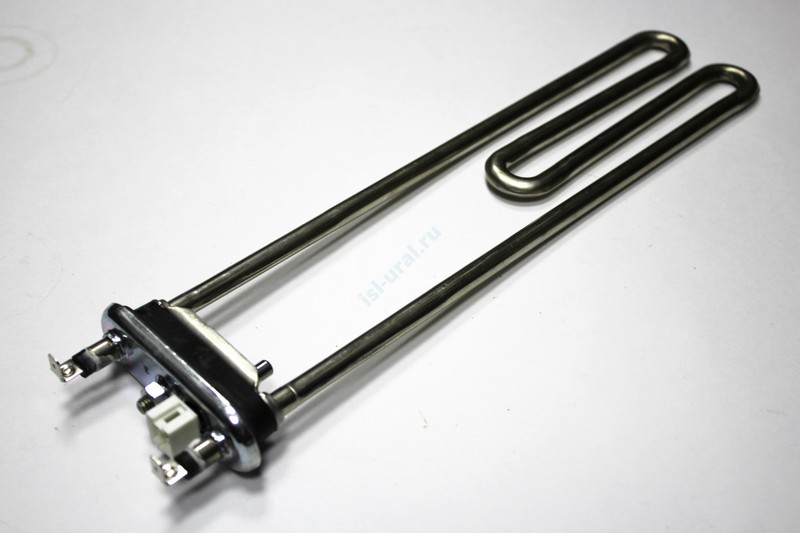
Power connection terminals;
Heating coil;
Heat-conducting insulator (located inside);
Ground terminal, a screw with a nut;
Rubber retainer;
- Pressure plate;
- Insulators of external power terminals.
A thermoelectric heater converts electrical energy into thermal energy, as a result of which the water heats up. The heating element freely heats the water to a set temperature; in some models of washing machines it is involved in drying. Many elements have a temperature sensor, which can be installed separately in the tank. When you turn on the washing machine and set a program, the control unit supplies the heating element with supply voltage, the heating element heats up itself and, accordingly, heats up the water. After the temperature sensor determines whether the set temperature has been reached, the control unit turns off the heating element, and the water will no longer heat up.
The heating element power can reach 2200 W, the stronger the thermoelectric heater, the faster the water in the washing machine will heat up. With powerful heating elements, the peak of washing productivity is reached faster.
Heating elements have good protection properties, they almost do not respond to different voltage supplies. Voltage fluctuations may occur in the power supply network, but this does not affect the conductive thread inside the heating element.This thin conductor has high resistance and has the potential to heat up. The heating process occurs without destruction and can reach high temperatures. The space from the wire to the walls of the tube is filled with a dielectric that is resistant to temperature increases.
The main units of a tubular heating element are:
sealed outer metal tube;
power connection terminals;
heating coil;
heat-conducting insulator (located inside);
grounding terminal, screw-in bolt with nut;
rubber retainer;
pressure plate;
insulators for external power terminals.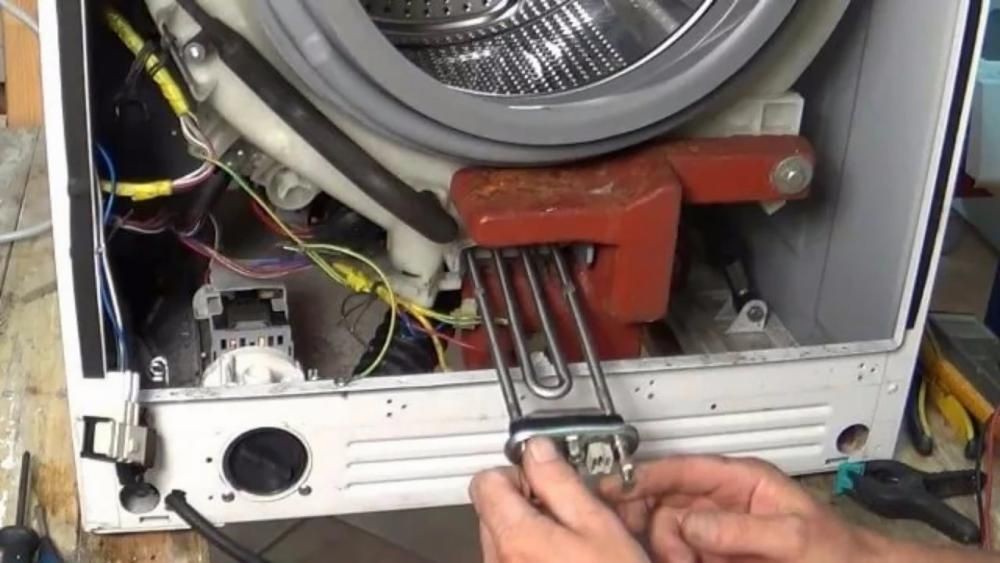
A thermoelectric heater converts electrical energy into thermal energy, causing the water to heat up. The heating element freely heats the water to the set temperature; in some models of washing machines it is involved in drying. Many elements have a temperature sensor that can be installed separately in the tank.
When you turn on the washing machine and set any program, the control unit delivers supply voltage to the heating element, the heating element heats up itself and, accordingly, warms up the water. After the temperature sensor determines whether the set temperature has been reached, the control unit will turn off the heating element, and subsequently the water will stop heating.
The power of the heating element can reach 2200 W; the stronger the thermoelectric heater, the faster the water in the washing machine will heat up.With powerful heating elements, the peak of washing productivity is achieved faster.
- Heating elements have good protection properties; they almost do not respond to different voltage supplies. Voltage changes may occur in the supply network, but this does not in any way affect the conductive thread inside the heating element. Therefore, the period of use of a thermoelectric heater is quite long.
- What parameters should you pay attention to when purchasing a new heating element?
One of the most important places of all components in washing units is occupied by heating elements. It heats cool water during the washing process, creates conditions for high-quality cleaning, and helps rid things of various contaminants.
Long-term use of a thermoelectric heater leads to a decrease in its technical properties, changes in quality and the occurrence of breakdowns.
If such a situation arises, you just need to replace the failed thermoelectric heater and continue to use the washing machine as usual. It is very easy to purchase a new heating element, even if you have no experience and lack knowledge.
- The electric heater (TEH) is responsible for heating the water to the required temperature, supplied from the public water supply to the washing machine. The shape resembles a W (V)-shaped; inside the heating element there is a conductor element that can withstand record temperatures. This internal structure is the same for all heating elements, therefore, when purchasing a new part, you need to pay attention to the external design features.
- The usual form of heating element is:
- straight;
- curved.
- It is better to purchase a straight heating element than a curved one. Its advantages are that most washing machines from various companies use exactly this form. A curved heating element is not much different from a straight one; it has an inclination of about 30 degrees. The quality of work is the same for different forms of parts.
- The tilting heating element model is used in a few popular washing machines, therefore, when purchasing a part, you need to clarify the model of your SMA. Heating elements have greater operating power, and the higher it is, the better it affects washing. When purchasing a failed heating element, you need to keep in mind that its power should remain the same as that of the previous heating element. Purchasing a part with a higher power may cause a malfunction of other components of the SMA.
- It is preferable to purchase heating elements from a company center or service center. It is better to take a new part, since a used one may have a short service life.
You should pay attention to the length of the thermoelectric heater. To do this, you need to measure it from the metal edge to the end of the heating component. The length should remain the same as that of the failed heating element. The permissible error may be 1.5 millimeters.
As for the power, a slight difference of 150 W is allowed, but it is better to keep the power the same. Large differences in power levels can also cause increased energy consumption as well as the amount of time it takes to heat up the water.
Another important point when purchasing a new part is checking the temperature sensor. You need to make sure whether it is in the SMA; some models only provide space for it. If the temperature sensor does not need to be replaced, then it can remain working with another new heating element. Such washing machines are cheaper in cost, since only the heating element is changed.
The new part must fit exactly the model of washing machine that you have. If this cannot be achieved, then you can buy a universal part.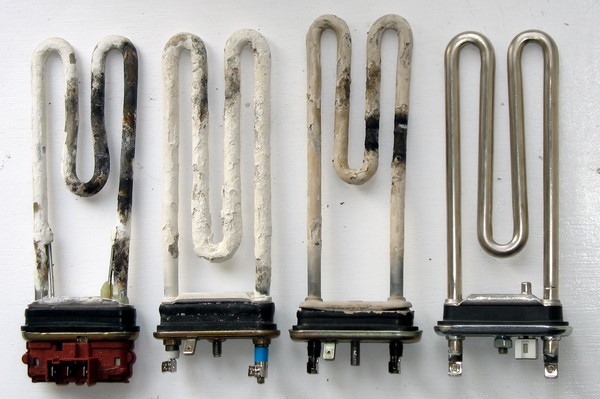
There must be an exceptional match in the quality of the material used in the production of the washing tub. The parts located under the tank are equipped with an elastic rubber gasket.
The terminals and all fasteners must be identical and fit together. A difference in location will lead to problems connecting the new part.
If the selection of a new part is carried out correctly, then the washing machine will work correctly and accurately meet the goals of the washing program.
The material from which the heating element is made and its outer coating may vary. There are no special requirements for this property. Deviations from the standards are permitted, as this will not affect the operation of the washing machine.
Where is the heating element located in the washing machine?
The heater is one of the most important parts. Therefore, it is imperative to know what it looks like, where it is located, and how to remove it.Then it is possible to check the heating element and replace it if it breaks.
Many washing machines from different manufacturers have heating elements located at the bottom. In this case, to replace the heating element, you need to remove the housing cover.
Depending on the specific washing machine, access to the heating element will occur:
- from the front;
- from the back.
- Some types of washing machines contain heating elements on the side. In case of repair, it is necessary to disassemble the side wall.
It is most convenient when the heating element is located at the back of the machine. In this case, you do not need to dismantle half of the washing machine housing, just remove the back panel and carefully examine the contents of the washing machine.
- Without preliminary preparation, it is unlikely that you will be able to figure out where the heating element is located. You need to do the following:
- disconnect the machine from the electricity;
- for the safety of the repair, check whether the housing is de-energized;
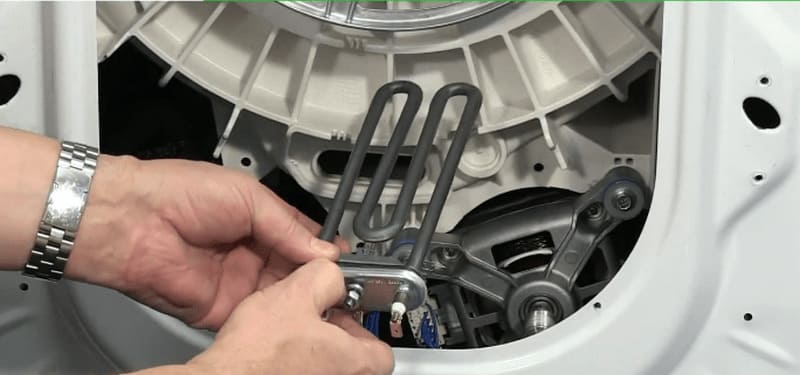
shut off the water supply;
disconnect the inlet and drain hoses;
- fasten long pipes and wires to the housing;
- provide free access to the machine, move it from the wall to the central part of the room;
- remove the back panel.
- It will not be possible to see the necessary part among the spare parts of the washing machine right away, since it is located deep inside. It is useless to look for the curved tube of the heating element, it is hidden far under the tank. The external contacts of the heating element are located outside.The temperature sensor contacts will also be located here. It is difficult to confuse the heating element with other units of the washing machine, since the wiring will be suitable for it.
- Reasons why heating elements fail
- The first reason is a manufacturing defect. Such a breakdown is rare, but it does occur. When purchasing even a new washing machine, there is a risk of purchasing defective components.
The second problem is scale, which settles on the electric heater and impairs the operation of the heating element. Once the metal body of the heater is covered with scale, the thermal conductivity decreases. Heat cannot be completely transferred to water, and the heating element overheats. Having received more heat than needed, the heating element fails. Scale actively forms when the temperature reaches more than 60 degrees; washing at a lower temperature is considered optimal.
Scale also promotes the formation of corrosion, which alters the metal shell. Having lost its tightness, the heating element becomes unprotected from external influences, and there is a risk of fires and short circuits. To avoid this type of breakdown, it is recommended to clean the inside of the machine with special means every few months.
One of the reasons that worsens the performance of the heating element is the use of unsuccessful detergents. The use of hand washing powder or its excess for one wash has an effect on the heating element and envelops it with a film.Therefore, it is better to use special anti-scale products.
Another reason for overheating, which is associated with the contact of various solid objects, skeins of wire, thread, and small pieces of fabric from laundry on the heating element.
Before washing, be sure to check the pockets of clothes placed in the machine and remove all unnecessary items.
Other reasons for the failure of the heating element of a washing machine are voltage surges, especially for houses in the private sector. In bad weather and a thunderstorm, it is better to turn off the power to the washing machine. If overheated for this reason, the heating element will look like new in appearance. There will be no visible signs of overheating or scale, but the heating element will not work.
There are times when the heating element turns on to heat water that has not entered the tank of the machine, and the heating element burns out. If a fuse is provided in the heating element pipe, then the damaged part appears without external damage. If there is no fuse, then an indicator of overheating of the heating element due to the lack of water will be the dark color of the metal tube, in some places peeling scale from elevated temperature conditions.
The new heating element can be installed in washing equipment after preventing the lack of water in the tank.
Heating elements may have the following types of faults:
Heating element rupture. With such a problem, the thread burns out, the electrical circuit breaks, and the heating element stops working.Such a malfunction entails a complete replacement of the part.
Current leakage, short circuit. Here the insulating layer of the heating element changes and a current appears on the body of the machine. With this malfunction, the part also changes.
As a result of the formation of a layer of scale, the heating element burns out completely, swells and is a consequence of electric current leakage. The surface of the heating element can be cleaned with special means or using citric acid.
Failure of the heating element occurs for a number of reasons, but you can try to avoid it in advance:
The cause of hard water can be eliminated by installing filters that make it soft and thereby prolong the operation of heating elements. Preventative work to clean the heating element will also not be superfluous.
Low mains voltage leads to an increase in current strength, and the core of the heating element may burn out. In this case, a voltage stabilizer is installed and the cause of its damage is eliminated.
- The temperature controller fails and does not give a timely signal about its change. As a result, the heating element overheats. If the regulator breaks down, it is unlikely that the heating element will turn off at the right time. If a problem is detected in time, it can be avoided in a timely manner.
- Self-check of the heating element’s performance
- Various malfunctions are possible if the water in the MAS is not heated. Most likely, the heating element, which is the heating element, has failed.To ensure this, you need to pay attention to the following problems:
- When washing things, the water remains cool and does not reach the set temperature.
The wash ends quickly after 8-10 minutes, but water flows into the tank.
- After starting the washing mashine, electrical plugs are knocked out.
- At the beginning of the streak, a burning smell occurs.
- The cleanliness of the linen is not the same as before.
- When you touch the washing machine, you feel an electric shock.
- If at least one of these signs is observed, then the heating element in the machine needs to be changed as quickly as possible. You can replace the part yourself or negotiate with a technician at a service workshop.
- For many types of washing equipment, the heating element is located behind. In this case, you need to remove the machine panel by unscrewing the screws. If the heating element is located in the front, then the actions are the same, only the heating element is located on the front side.
You need to look for the heating part in the lower location of the tank and try to disconnect it from the wires. In order not to lose track of the connections, you need to photograph the contacts and only then remove them. When taking out the heating element, you need to unscrew the nut located in the middle of the heating element. The visible bolt should go inside; to do this, you need to press on the end of the bolt.
When taking out the heating element, you need to pry it off with some object, for example, a screwdriver. After removal, it is easy to check its functionality. For this purpose, a visual inspection method is used.You just need to carefully inspect the part. If dark marks in the form of small spots are noticeable on the heating element, then most likely the housing of the heating element is broken. Traces of scale will also be visible visually.
- By carefully studying the heating element, you can understand the method of fixing it on the tank and understand how sealing is carried out. After the nut is tightened, the rubber fastening mechanism becomes wider. Due to expansion, the heater is securely held in place and does not allow water to get inside the washing machine.
- The heating element can be removed only after twisting the nut and pressing on the stud to deepen it inward. You must use a screwdriver to remove the heating element carefully, without breaking the tank; in some models of machines it is very fragile, and there is a possibility of damaging it.
- When returning the heating part to its previous recess, you must carefully monitor that it fits into the required opening in the lower part of the tank. If the heating element is moved upward, it may touch the drum; the problem will be revealed during the spinning process.
- How to replace the heating element with your own hands
- After finding out the reasons for the lack of water heating, it is necessary to move on to solving the problem that has arisen. It is not difficult to replace an electric heater with another one on your own; you must follow the following rules.
- Step 1. Determine the location of the heater.
- First, determine in which part of the washing equipment the electric heater is located.The machine is moved away from the wall, the body is turned around, and the rear surface is checked. If the back cover is large and covers the entire width and length, then the heating element is located on the rear of the equipment. The process of replacing the heating element is simple, you just need to take a screwdriver and unscrew the cap to find an electric heater under the tank.
- If there is a small flap at the back of the MAC, then it is designed to approach the washing machine belt. The heating element in this version is located at the front; it can also be found at the bottom. Here, the process of replacing a part is longer and more complex, since for repairs you need to disassemble the panel from the front.
- If the washing machine has a vertical loading, the heating element can be replaced through the wall, which is located on the side or bottom. The cover can be removed without much difficulty.
- Step 2: Create a fastening approach.
- After establishing the location of the heating element in the machine, you need to start disassembling the body to replace the technical part. To do this you need to do the following:
- turn off the machine from the power supply to prevent electric shock;
when you are behind, turn off the water by disconnecting the drain pipe;
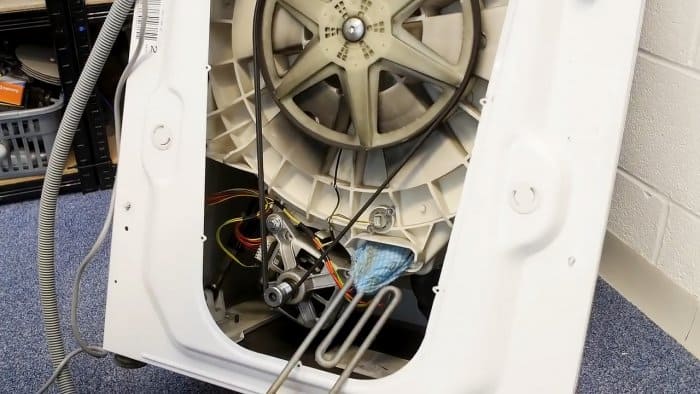
drain the water remaining after the last wash through the drain filter, lowering it below the washing machine;
remove the back surface.
If you need to remove the front cover, follow these steps:
Remove the lid on top.
Remove the tray for powder and other products. The tray is attached with self-tapping screws and secured with a latch, which is carefully released.
Remove the steel hoop from the seal on the lid. The holding spring needs to be pulled back a little, the hoop removed and the seal removed.
Remove the door lock by disconnecting the wires from it.
- Remove the front panel by unscrewing the screws or clips.
- Proceed to replace the heating element.
Step 3. Dismantle the heating element.
The heating element is secured with just one nut. Before unscrewing it, you need to disconnect the power wires and remove the ground from the temperature sensor:
Take a socket or open-end wrench and unscrew the nut attached to the heating element.
Do not unscrew the nut completely.
Press the visible pin inward and remove the heating element from its place.
Unscrew the nut completely, carefully remove the heating element, gradually loosening it.
Check the electric heater. If replacement is necessary, install a new heating element.
Reassemble in reverse order.
Clean the recess in which the heating element is located, remove accumulated debris and excess powder.
To prevent water leakage, the new electric heater can be secured additionally using sealant.
If the seat is not damaged when dismantling the heating element, no further leakage will occur.









